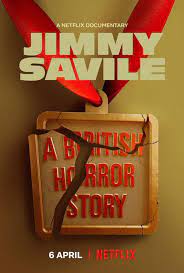
JIMMY SAVILE: A BRITISH HORROR STORY
UK, 2022, 125 minutes, Colour.
Directed by Rowan Deacon.
The story of British entertainer Jimmy Savile, his legendary impact on British audiences for almost half a century, then his being unmasked as a monstrous predator was a shock to most people. His story is alarming in so far as a public figure can have such a respected reputation, mix with everyone, including the British Royal family and Prime Minister, Margaret Thatcher, raise millions voluntary work in hospitals, can yet have a private life and be a long time abuser. (Australia has had its parallel experience with Rolf Harris.)
This documentary has two parts. While, in the first part there is acknowledgement of Jimmy Savile’s life and behaviour, the aim is to communicate to the television audience the life, the entertainment career, the public face of Jimmy Savile. For British audiences who remember him, it will be more than a walk down memory lane, seeing the adoring crowds, his playing to the crowds. For those audiences not familiar with him, it will seem extraordinary, irrespective of whether he was a criminal on not, that who could achieve such a public persona, be ever present, and receive such broad acclaim.
Which means then that the first part of the documentary continually raises the enigma of who Jimmy Savile really was. It means that the second part of the documentary will be the investigation of his life, indications of complaints for decades, the reaction of the police, the disbelief that such a public figure could be a predator, the gradual growth of complainants and the consequences.
There is an extraordinary amount of television footage available for the documentary makers, going back to the 60s, the beginnings of his career, his work as a DJ, Top of the Pops, the very popular show, especially aimed at children, indicating that Jimmy could fix anything, the children writing letters with their dreams, and his achieving them for the television audience, visits to Israel, a young girl patrolling with the police in Downing Street… There is the wondrous reaction of the children, the acclaim of parents, of the general public.
He suddenly presented as an eccentric, in his clothes, in his hair over the decades, in his look (a touch of the Marty Feldman), his manner of speaking, his wisecracks. The film also highlights the extraordinary lengths he went to to raise millions of pounds for charities, 28 years he spent as a volunteer as an ambulance man or working in the hospitals. There are grateful authorities. There are grateful members of the public, and, especially, those with spinal injuries. There are all kinds of stunts that he performed, walks, running, his passion for wrestling, bike riding.
The film also makes a great deal of his friendship with the Royal family, chatting with the Duke of Edinburgh showing him round, a friendship with Prince Charles and Charles writing to him to get advice for speeches, Diana coming to the hospitals and meeting with the patients. He also became firm friends with Margaret Thatcher, many scenes with them together, her promoting him to knighthood. He is pictured on many of the talk shows, especially with Michael Parkinson, and celebrity guests like Alan Alda.
But, in the first part, there is talking heads like theatre critic, Mark Lawson, who are indicating suspicions. In the second part, there is the journalist Meiron Jones, who for some years investigated Savile, try to persuade the BBC to screen his program, ITV taking it up – and his later being vindicated. There is also the chief of London police, Michael Hames, who began investigations but retired from the force, seen talking in retrospect.
And, some victims emerge, some giving extensive interviews to the screen, some explicit descriptions of Savile’s misbehaviour and molestation. And these increased during the second part. There is the strange phenomenon that several would joke about his private life, about the ladies, about his case coming up next Thursday…
Throughout the documentary there are many talking heads, especially from a number of journalists who interviewed him on radio and television, looking actually at the footage in their later lives, some disbelief. There is also the disbelief of his biographer, Alison Bellamy, who was befriended by Savile and who now has boxes of his documents, reading from some of his letters, especially the correspondence with Prince Charles. And there is Roger Ordish, looking back in some disbelief, on the years that he produced the children’s program, 1975-1994.
The film raises the question about samples life, his Catholic background, his bond with his mother, his career and being continually on the move, living in a caravan, no one-to-one relationships, some of the journalist probing this with him and his offhand answers, or refusal to answer. The point is made that he lived his persona, cheerful, always active, always an eye on the camera, looking straight to camera and winking, depending on the adulation of the crowd. There are some psychologist remarks about his triumphant attitude, superiority, that he was always right.
During the 2010 is, there were the revelations about his past. While the film shows his Catholic requiem and burial, there are also scenes where the rather large Tombstone was removed during the night and destroyed.
In many ways, watching this documentary is a gruelling experience, a puzzling experience, and, in view of revelations about public figures, a disillusioning experience.
(Netflix released at the same time, a documentary on the serial killer, John Wayne Gacy, and his being unmasked eventually as the decades-long predator. It is very clear from the Jimmy Savile documentary, Savile created a media persona, living up to it, developing it, association with the rich and famous, but revealing very little of his underlying personality and monstrous behaviour. From the Gacy interview tapes, we hear Gacy himself creating a similar kind of persona which people responded to favourably, until this persona-mask was taken away and the truth revealed.)